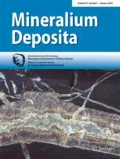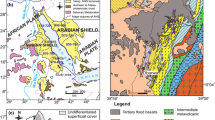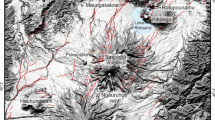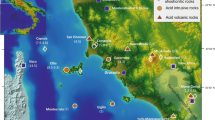Abstract
The Eocene–Miocene volcanic and hypabyssal rocks of the El Indio-Pascua Au–Ag–-Cu belt in the southern central Andean flat-slab region are medium–high-K calc-alkaline arc suites, ranging in composition from andesite to rhyolite. A significant transition in magmatic trace element chemistry, coinciding with a pronounced reduction in magma output, occurred in the late-Middle Miocene as documented by 40Ar–39Ar geochronology. The upper Eocene–lower-Middle Miocene rocks exhibit low Sr/Y ratios (<50), minor heavy REE fractionation with Sm/Yb ratios not exceeding 3.5 and, in some cases, minor negative Eu anomalies. In contrast, the largely dacitic rocks erupted after ca. 13 Ma are depleted in Y (≤10 ppm), have generally high, but variable Sr/Y ratios (30–200), exhibit moderate middle and heavy REE fractionation (Sm/Yb: 3.7–5.9) and lack negative Eu anomalies. The latter features are characteristic of adakitic suites (i.e. slab-melts), but the regional temporal and spatial distribution of arc magmatism precludes a major magma source in the downgoing slab. This evolution is interpreted as reflecting a progressive increase in pressure and the availability of water in the lower-crustal site of magma generation, establishing both garnet and hornblende as major stable phases in the residuum. The pressure in the lower crust increased in response to episodic crustal thickening related to the shallowing of the slab, a process recorded by the incision of three regional pediplains over the period 17–6 Ma. Elimination of the subarc asthenospheric mantle and much of the lithospheric mantle by ca. 10 Ma permitted direct incursion of slab-derived, highly oxidised metal- and volatile-rich supercritical fluids into the lower crust, stimulating melting of mafic, garnet amphibolitic and eclogitic assemblages.
The igneous suites emplaced from 36–11 Ma were associated with widespread, and locally intense, epizonal hydrothermal activity, but this was barren of base and precious metals. The shallow-crustal availability of abundant water highlighted in earlier models was therefore not a metallogenetic determinant. Moreover, economic Au–Ag–Cu mineralization, associated with small volumes of dacitic magma, was restricted to the interval 9.5–5 Ma, and was not initiated until at least 3.5 my after the inception of high-pressure magma generation. In contrast to previous metallogenetic studies, we therefore suggest that this petrochemical transition was not inherently favourable for ore formation. We propose that the incursion of highly oxidized supercritical fluids from the slab into the lower crust was ultimately responsible for the brief Late Miocene metallogenetic episode.










Similar content being viewed by others
References
Atherton MP, and Petford N (1993a) Plutonism and the growth of Andean crust at 9óS from 100 to 3 Ma. Proceedings of the 2nd International Symposium on Andean Geodynamics, Oxford,pp 21–23
Atherton MP, Petford N (1993b) Generation of sodium-rich magmas from newly underplated basaltic crust. Nature 363:144–146
Bissig T (2001) Metallogenesis of the Miocene El Indio-Pascua gold–silver–copper belt, Chile/Argentina: geodynamic, geomorphological and geochemical controls on epithermal mineralization. PhD Thesis, Queen's University, Kingston, Ontario, 531 pp
Bissig T, Lee JKW, Clark AH, Heather KB (2001) The Neogene history of volcanism and hydrothermal alteration in the Central Andean flat-slab region: new 40Ar–39Ar constraints from the El Indio-Pascua Au (Ag, Cu) belt, III/IV Region, Chile, Provincia San Juan, Argentina. Int Geol Rev 43:312–340
Bissig T, Clark AH, Lee JKW, Hodgson CJ (2002a) Miocene landscape evolution in the Chilean flat-slab transect: uplift history and geomorphologic controls on epithermal processes in the El Indio-Pascua Au (–Ag, Cu) belt. Econ Geol 97:971–996
Bissig T, Clark AH, Lee JKW, (2002b) Cerro de Vidrio rhyolitic dome: evidence for Late Pliocene volcanism in the central Andean flat-slab region, Lama-Veladero district, 29 20′S, San Juan Province, Argentina. J S Am Earth Sci 15:571–576
Barreiro BA, Clark AH (1984) Lead isotopic evidence for evolutionary changes in magmacrust interaction, Central Andes, southern Peru. Earth Planet Sci Lett 69:30–42
Cahill T, Isacks BL (1992) Seismicity and shape of the subducted Nazca Plate. J Geophys Res 97:17503–17529
Charchaflié D (2003) Geological structural and geochronological framework of the Veladero North Area, Cordillera Frontal, Argentina. MSc Thesis, University of British Columbia, Vancouver, BC, 125 pp
Clark, AH (1993) Are outsized porphyry copper deposits either anatomically or environmentally distinctive?. Society of Economic Geologists Special Publication No 2, Littleton, Colorado, pp 213–283
Clark AH, Farrar E, Caelles JC, Haynes SJ, Lortie RB, McBride SL, Quirt GS, Robertson, RCR, Zentilli M (1976) Longitudinal variations in the metallogenic evolution of the Central Andes: a progress report. Geological Association of Canada, Special Paper No14, Toronto, Ontario, pp 23–58
Davies CR (2000) Au–Cu deposits in the Cajamarca region, northern Peru. In: Abstract with programs from the 96th Annual Meeting of the Geological Society of America, Cordilleran Section, Vancouver, BC, 32:9
Defant MJ, Drummond MS (1993), Mount St. Helens: potential example of the partial melting of the subducted lithosphere in a volcanic arc. Geology 21:547–550
Defant MJ, Kepezhinska P (2001) Evidence suggests slab melting in arc magmas. EOS transactions no 20, American Geophysical Union, Washington, DC, pp 67–69
Dostal J, Zentilli M, Caelles JC, Clark AH (1977) Geochemistry and origin of volcanic rocks of the Andes (26–28°S). Contrib Mineral Petrol 63:113–128
Drummond MS, Defant MJ (1990) A model for trondhjemite–tonalite–dacite genesis and crustal growth via slab-melting: Archean to modern comparisons. J Geophys Res 95:21503–21521
Feeley TC, Davidson JP (1994) Petrology of calc-alkaline lavas at Volcán Ollagüe and the origin of compositional diversity at central Andean stratovolcanoes. J Petrol 35:1295–1340
Fulignati P, Gioncada A, Sbrana A (1999) Rare-earth element (REE) behavior in the alteration facies of the active magmatic-hydrothermal system of Volcano, Aeolian Islands, Italy. J Volcanol Geotherm Res 88:325–342
Gordillo CE, Linares E (1982) Geocronología y petrografía de las vulcanitas Terciarias del departemento Pocho, provincia de Córdoba. Rev Asoc Geol Argentina 36:380–388
Gregory-Wodzicki KM (2000) Uplift history of the Central and Northern Andes: a review. Geol Soc Am Bull 112:1091–1105
Groeber P (1951) La Alta Cordillera entre las latitudes 34° y 29°30′ S. Rev Cien Geol Mus Argentino Cienc Nat Buenos Aires I(5):1–352
Gutscher M-A, Maury R, Eissen J-P, Bourdon E (2000) Can slab melting be caused by flat subduction? Geology 28:535–538
Haschke M, Günther A, Siebel W, Scheuber E, Reutter K-J (2001) Magma source variations of late Cretaceous–late Eocene magmatic rocks of the Chilean Precordillera (21.5–26°S): due to variable water fugacity or crustal thickening? poster on http://sfb267.geoinf.fu-berlin.de/web/de/poster/posterb.asp
Heather KB, Díaz D (2000) El Indio–Tambo district regional geological mapping program 1997–1999. Company Report, Barrick Chile Ltda, 16 maps, 284 pp
Hildreth W, Moorbath S (1988) Crustal contributions to arc magmatism in the Andes of central Chile. Contrib Mineral Petrol 98:455–489
Jannas RR (1995) Reduced and oxidized high sulfidation deposits of the El Indio District, Chile. PhD Diss, Cambridge, Massachusetts, Harvard University, 421 pp
Jordan TE, Almendinger RW, Damanti J, Drake R (1993) Chronology of motion in a complete thrust belt: the pre-Cordillera 30–31 °S, Andes Mountains. J Geol 101:133–156
Jordan TE (2000) Deformation and topography in the Sierras Pampeanas, Argentina: responses to flat subduction. In: Abstracts with programs from the Annual Meeting of the Geological Society of America, Reno, Nevada, 33,525 pp
Kay RW (1978) Aleutian magnesian andesite: melts from subducted Pacific ocean crust. J Volcanol Geotherm Res 4:497–522
Kay SM, Abruzzi JM (1996) Magmatic evidence for Neogene lithospheric evolution of the central Andean "flat-slab" between 30 and 32°S. Tectonophysics 259:15–28
Kay SM, Gordillo CE (1994) Pocho volcanic rocks and the melting of depleted continental lithosphere above a shallowly dipping subduction zone in the central Andes. Contrib Mineral Petrol 117:25–44
Kay SM, Maksaev V, Moscoso R, Mpodozis C, Nasi C (1987) Probing the evolving Andean lithosphere: Mid–Late Tertiary magmatism in Chile (29–30°30′S) over the modern zone of subhorizontal subduction. J Geophys Res 92:6173–6189
Kay SM, Mpodozis C (2001) Central Andean ore deposits linked to evolving shallow subduction systems and thickening crust. GSA Today (Geol Soc Am) 11(3):4–9
Kay SM, Mpodozis C (2002) Magmatism as probe to the Neogene shallowing of the Nazca plate beneath the modern Chilean flat-slab. J S Am Earth Sci 15:39–57
Kay SM, Mpodozis C, Ramos VA, Munizaga F (1991) Magma source variations for mid-late Tertiary magmatic rocks associated with a shallowing subduction zone and a thickening crust in the central Andes (28–33°S). In: Harmon RS, Rapela C (eds) Andean magmatism and its tectonic setting. Geological Society of America Special Paper 265, Littleton, Colorado, pp 113–137
Kay SM, Mpodozis C, Tittler A, Cornejo P (1994) Tertiary magmatic evolution of the Maricunga mineral belt in Chile. Intl Geol Rev 36:1079–1112
Kay SM, Mpodozis C, Coira C (1999) Neogene magmatism, tectonism and mineral deposits of the Central Andes (22–33 °S Latitude). In: Skinner BJ (ed) Geology and ore deposits of the central Andes. Society of Economic Geologists Special Publication No 7, College Station, Texas, pp 27–59
King A (1992) Geology and gold mineralization in the Chilean Andes. PhD Thesis, London, Imperial College, 365 pp
Limarino CO, Gutiérrez PR, Malizia D, Barreda V, Page S, Ostera H, Linares E (1999) Edad de las secuencias paleógenas y neógenas de las cordilleras de la Brea y Zancarrón, Valle del Cura, San Juan (nota breve). Rev Asoc Geol Argentina 54:177–181
Macfarlane AW (1999) Isotopic studies of northern Andean crustal evolution and ore metal sources. In: Skinner BJ (ed) Geology and ore deposits of the central Andes. Society of Economic Geologists Special Publication No 7, College Station, Texas, pp195–217
Maksaev V, Moscoso R, Mpodozis C, Nasi C (1984) Las unidades volcánicas y plutonicas del cenozoico superior en la Alta Cordillera del Norte Chico (29–31 °S): geología, alteración hidrothermal y mineralisación. Rev Geol Chile 21:11–51
Martin MW, Clavero JR, Mpodozis CM, Cutiño LG (1995) Estudio geológico regional de la franja El Indio, Cordillera de Coquimbo. Informe registrado IR-95–6 Servicio Nacional de Geología y Minería, Chile, and Compañía Minera San José, 232 pp
Martin MW, Clavero JR, Mpodozis CM (1997) Eocene to Late Miocene magmatic development of the El Indio belt, ~ 30 °S, north-central Chile. VIII Congr Geol Chileno Actas 1:149–153
Martin MW, Clavero JR, Mpodozis CM (1999) Late Paleozoic to Early Jurassic tectonic development of the high Andean Principal Cordillera, El Indio Region, Chile (29–30°S). J S Am Earth Sci 12:33–49
Matthews SJ, Jones AP, Gardeweg MC (1994) Lascar volcano, northern Chile; evidence for steady-state disequilibrium. J Petrol 35:401–432
Molnar P, England P (1990) Late Cenozoic uplift of mountain ranges and global climate change: chicken or egg? Nature 346:29–34
Mungall EJ (2002) Roasting the mantle: slab melting and the genesis of major Au and Au-rich Cu deposits. Geology 30:915–918
Muntean JL, Einaudi MT (2001) Porphyry-epithermal transition: Maricunga Belt, northern Chile. Econ Geol 96:743–772
Peccerillo A, Taylor SR (1976) Geochemistry of Eocene calc-alkaline volcanic rocks from the Kastamonu area, northern Turkey. Contrib Mineral Petrol 58:63–81
Pilger RH Jr (1984) Cenozoic plate kinematics, subduction and magmatism: South American Andes. J R Geol Soc Lond 141:793–802
Prouteau G, Scaillet B, Pichavant M, Maury RC (1999) Fluid-present melting of ocean crust in subduction zones. Geology 27:1111–1114
Ramos VA, Mahlburg-Kay S, Page RN, Munizaga F (1989) La ignimbrita Vacas Heladas y el cese del volcanismo en el Valle del Cura, Provincia de San Juan. Rev Asoc Geol Argentina 44:336–352
Rapp RP (1995) Amphibole-out phase boundary in partially melted metabasalt, its control over liquid fraction and composition, and source permeability. J Geophys Res 100:15601–15610
Rapp RP, Watson EB (1995) Dehydration melting of metabasalt at 8.32 kbar: implications for continental growth and crust-mantle recycling. J Petrol 36:891–931
Richards JP, Boyce AJ, Pringle MS (2001) Geologic evolution of the Escondida area, northern Chile: a model for spatial and temporal localization of porphyry Cu mineralization. Econ Geol 96:271–305
Richards JP (2002) Discussion on "Giant versus small porphyry copper deposits of Cenozoic age in northern Chile: adakitic versus normal calc-alkaline magmatism" by Oyarzún et al. Miner Deposita 37:788–790
Sajona FG Maury RC (1998) Association of adakites with gold and copper mineralization in the Philippines. C R Acad Sci Paris Sci Terre Planèt 326:27–34
Sandeman HA, Clark AH Farrar E (1995) An integrated tectono-magmatic model for the evolution of the southern Peruvian Andes (13–20°S) since 55 Ma. Int Geol Rev 37:1039–1073
Sasso AM, Clark AH (1998) The Farallón Negro Group, Northwest Argentina: magmatic hydrothermal and tectonic evolution and implications for Cu-Au metallogeny in the Andean back-arc. Soc Econ Geol Newsl 34:18–18
Sen, C, Dunn T (1994) Dehydration melting of a basaltic composition amphibolite at 1.5 and 2.0 Gpa: implications for the origin of adakites. Contrib Mineral Petrol 117:394–409
Siebel W, Schnurr WBW, Hahne K, Kraemer B, Trumbull RB, Van den Bogaard P, Emmermann, R (2001) Geochemistry and isotope systematics of small- to medium-volume Neogene-Quaternary ignimbrites in the southern central Andes: evidence for derivation from andesitic magma sources. Chem Geol 171:213–237
Skewes MA, Stern CH (1994) Tectonic trigger for the formation of Late Miocene Cu-rich megabreccias in the Andes of central Chile. Geology 22:551–554
Sillitoe RH (1976) Andean mineralization: a model for the metallogeny of convergent plate margins. Geological Association of Canada, Special Paper no 14, Toronto, pp 59–100
Skewes MA, Stern CH (1995) Genesis of the giant Late Miocene to Pliocene copper deposits of central Chile in the context of Andean magmatic and tectonic evolution. Int Geol Rev 37:71–84
Skewes MA, Arévalo A, Floody R, Zuñiga PH, Stern CR (2002) The giant El Teniente breccia deposit: hypogene copper distribution and emplacement. Society of Economic Geologists, Special Publication No 9, College Station, Texas, pp 299–332
Stacey JS Kramers JD (1975) Approximation of terrestrial lead isotope evolution by a two stage model. Earth Planet Sci Lett 26:207–221
Stern CR (1991) Role of subduction erosion in the generation of Andean magmas. Geology 19:78–81
Stern CR (2001) The subduction erosion and mantle source region contamination model of Andean arc magmatism: isotopic evidence from igneous rocks of central Chile. III Simposio Sudamericano de Geología Isotópica, Pucón, Chile, Extended Abstracts: pp 348–351
Strusievicz RO, Clark AH, Lee JKW, Farrar E, Slauenwhite M, Hodgson CJ (2000) Metallogenetic relationships of the Huaraz, Ancash, segment of the precious-base metal sub-province of northern Peru. In: Abstracts with Programs of the Geological Society of America Annual Meeting, Reno, Nevada, 33, 504 pp
Taylor SR, McLennan SM (1985) The continental crust: its composition and evolution. Blackwell, Oxford, 312 pp
Tepper JH, Nelson, BK, Bergantz GW, Irving AJ (1993) Petrology of Chilliwack batholith, north Cascades, Washington: generation of calc-alkaline granitoids by melting of mafic lower crust with variable water fugacity. Contrib Mineral Petrol 113:333–351
Thieblemont D, Stein G, Lescuyer JL (1997) Gisements épithermaux et porphyriques: la connexion adakite. C R Acad Sci Paris Sci Terre Planèt 325:103–109
Thiele R (1964) Reconocimiento geológico de la Alta Cordillera de Elqui. Universidad de Chile. Departamento de Geología, Publicación No 27, 73 pp
Tosdal RM (1995) Metal source differences in Cenozoic prophyry Cu–Mo–Au deposits in the central Chilean Andes between 26 and 28°S: an influence on the size of porphyry deposits? In: Clark AH (ed) Proceedings of the Second Giant Ore Deposits Workshop, Kingston, ON, Giant ore deposits II: controls on the scale of orogenic magmatic-hydrothermal mineralization, pp 137–151
Tosdal RM, Munizaga F (1996a) Age and geographic variations in sulfide Pb isotopic compositions of Mesozoic and Cenozoic Andean ore deposits between La Serena and Santiago, Chile (30–34 °S). Congresso Brasileiro de Geologia, Salvador, Sept 1–6, 1996. Anais 7:332–336
Tosdal RM, Munizaga F (1996b) Basement influences on ore deposits in the Chilean Andes (30–40 °S). In: Abstracts with programs from the annual meeting of the Geological Society of America, New Orleans, Louisiana, 28, p 154
Tosdal RM, Munizaga F (2003) Lead sources in Mesozoic and Cenozoic Andean ore deposits, north central Chile (30–34°S). Mineral Deposita 38: 234–250
Tosdal RM, Wooden JL, Bouse RM (1999) Pb isotopes ore deposits and metallogenetic terranes. Rev Econ Geol 12:1–28
Unruh DM Tatsumoto M (1976) Lead isotopic composition and U, Th and Pb concentrations in sediments and basalts from the Nazca Plate. In: Yeats RS, Hart SR (eds) Initial Reports of the Deep Sea Drilling Project 34, pp 341–347
Yañez GA, Ranero CR, von Huene R, Díaz J (2001) Magnetic anomaly interpretation across the southern central Andes (32–34°S): the role of the Juan Fernandez Ridge in the late Tertiary evolution of the margin. J Geophys Res 1206:6325–6345
Acknowledgments
This study, a contribution to the Queen's University Central Andean Metallogenetic Project (CAMP), originated as part of the senior author's doctoral dissertation. Field work and one-half of the analytical research was funded by Barrick Gold Corporation, Toronto, and Barrick Exploraciónes Argentina S.A., through the good offices of C. Jay Hodgson and David Heberlein. Barrick further contributed a bursary to T.B. Additional funds for laboratory research and support were provided by the Natural Sciences and Engineering Research Council of Canada as personal grants to A.H.C. and J.K.W.L. Assistance from the geological and support staff of Barrick Chile Ltda. and Barrick Exploraciónes Argentina S.A. is acknowledged. Doug Archibald, Jerry Grant and Tom Ullrich assisted in the Queen's University Geochronology Laboratory. Joan Charbonneau expertly typed the manuscript. We thank Jeremy Richards for a constructive and stimulating review. Suggestions by Andor Lips and editor Larry Meinert helped to reduce the length of this paper. Barrick Gold Corporation has given permission for publication.
Author information
Authors and Affiliations
Corresponding author
Additional information
Editorial handling: V. Bouchot
Electronic Supplementary Material
Rights and permissions
About this article
Cite this article
Bissig, T., Clark, A.H., Lee, J.K.W. et al. Petrogenetic and metallogenetic responses to Miocene slab flattening: new constraints from the El Indio-Pascua Au–Ag–Cu belt, Chile/Argentina. Miner Deposita 38, 844–862 (2003). https://doi.org/10.1007/s00126-003-0375-y
Received:
Accepted:
Published:
Issue Date:
DOI: https://doi.org/10.1007/s00126-003-0375-y




